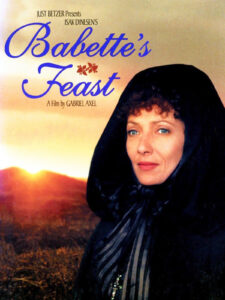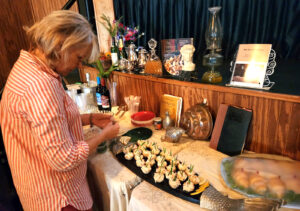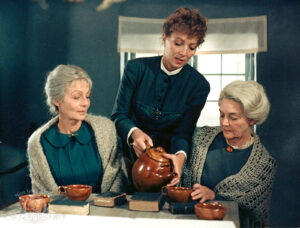Epicurean ecstasy: Bosque Film Society hosts Bosque Arts Center Culinary Club for screening of 1987 Danish treat “Babette’s Feast” at The Cliftex Theatre Sept. 12
By SIMONE WICHERS-VOSS
Bosque Film Society Founding Board Member
In collaboration the Bosque Film Society, the Bosque Arts Center Culinary Club will host an evening of FREE film and food with the charm and melancholy, screening the 1987 Danish drama BABETTE’S FEAST at the historic Cliftex Theatre in downtown Clifton on September 12 at 5:30 p.m. for a private viewing sponsored by Brett and Simone Voss of Chisholm Country magazine: www.ChisholmCountry.com.
 Prior to the film viewing, the Bosque Film Society will offer a short presentation with background information on the award-winning film, and will provide wine and beer for the occasion. Culinary Club members are encouraged to bring their favorite finger food, because the mouthwatering dishes in the movie are bound to make you hungry for a tasty something or other.
Prior to the film viewing, the Bosque Film Society will offer a short presentation with background information on the award-winning film, and will provide wine and beer for the occasion. Culinary Club members are encouraged to bring their favorite finger food, because the mouthwatering dishes in the movie are bound to make you hungry for a tasty something or other.
As both a Bosque Film Society board member and Bosque Arts Center Culinary Club member, and with so many great foodie films out there, I thought it would be a wonderful opportunity to marry Film and Food. BAC Culinary Club President Virginia Richards agreed to hosting this evening as the September Culinary Club meeting.
In my eyes, this private viewing offers one of the best “foodie” movies of all-time with the charming and melancholy 1987 Danish drama “Babette’s Feast” surely to become a treat, especially with all the snacks the culinary club members brought for the evening.
Being a true foodie, my television viewing of choice is food shows and my travel bucket list includes multiple exotic dishes I want to try in faraway lands – I will try any dish once, just to have experienced the taste, texture and the culture associated with it. And foreign supermarkets are a treat for me – you can read a country’s culture in the food they have available. I have been found guilty of calling Bosque County a culinary desert, not because of a lack of restaurants, but because of the lack of choice fresh ingredients. Sure, we can drive to Whole Foods in Fort Worth, but that’s just not feasible for a weekday special meal.
Why am I a foodie? Mainly because I like to cook — to bake mind you, cook. But why do I like to cook?
In my youth, my favorite place to be was in the kitchen where all the goodies for one of my mother’s bridge parties and company dinners were being prepared – from feeding the live turkey a shot of brandy before it met its demise with the sharp kitchen knife to help butchering half a hog some business associates were so kind to provide.
 Nothing was wasted – I got to pick the meat off the bones for the head cheese and mince the bits and pieces for the sausage filling; the liver prepared with sherry and parsley and the kidneys soaked in milk overnight before making steak and kidney pie.
Nothing was wasted – I got to pick the meat off the bones for the head cheese and mince the bits and pieces for the sausage filling; the liver prepared with sherry and parsley and the kidneys soaked in milk overnight before making steak and kidney pie.
I got to help with the serving at dinner parties and I loved seeing how people enjoyed the many different dishes that were served, and how the blushing hibiscus floral center piece turned from white to a soft pink to red during the course of the meal – it’s quite spectacular. It’s called Hibiscus Mutabilis for those who want to know.
I loved the conviviality at the table, learning that good food, fine wines and excellent conversation made it easier for people to communicate and forget their differences. And cooking a tasty meal for someone is also my way of showing my love for them, through nourishment of their stomachs and souls.
Maybe that’s why I find the cliché’s of “food conquers all” and “the way to a person’s heart is through their stomach” ring true. I have my mother’s cookbook from the Amsterdam School of Home Economics, received from her employer a general practitioner in 1956 before she embarked on life’s adventures with my father. His inscription said “Ria, all love goes through the stomach,” and her inscription read “A cookbook is as a very attractive woman; the more you delve into her, the more you value and cherish her.”
And that is probably why I love this movie so much, as it incorporates all of these things.
“Nourishing both the senses and the religious imagination with its profound representation of food and eating, the 1988 Oscar winner for Best Foreign Language Film remains the gold standard for food films,” a film critic said.
 A timeless Scandinavian treat, the film (original name Babettes Gaestebud) from Director Gabriel Axel and co-written with Isak Dinesen – yes, the same author that wrote “Out of Africa” – explores the complex relationships between people, beliefs, cultures and what it means to be a culinary artist. Foodies be warned, though, most of the film shows the back story of the congregation, the two sisters, former suitors, their father’s manipulation to keep his girls close by his side in spite of their talents.
A timeless Scandinavian treat, the film (original name Babettes Gaestebud) from Director Gabriel Axel and co-written with Isak Dinesen – yes, the same author that wrote “Out of Africa” – explores the complex relationships between people, beliefs, cultures and what it means to be a culinary artist. Foodies be warned, though, most of the film shows the back story of the congregation, the two sisters, former suitors, their father’s manipulation to keep his girls close by his side in spite of their talents.
It helped the foreign language film enormously that Sydney Pollack’s award-winning “Out of Africa” with Robert Redford and Meryl Streep two years earlier made Dinesen a familiar name world-wide. When “Babette’s Feast” first came to theaters, the U.S. distributor Orion Classics arranged special dinners at the restaurant Petrossian in Manhattan and elsewhere and the New York Times offered some background and several recipes from the meal.
During the late 19th Century, a strict religious community in a tiny Scandinavian fishing village takes in a Papist French refugee from the Franco-Prussian War Babette Hersant as a servant to the late pastor’s daughters Filippa and Martine. Twelve years later, Babette – played by French actress Stéphane Audran – receives a letter announcing she won 10,000 francs in the Paris lottery.
Instead of packing her bags and leave to make a live for her own, Babette decides to treat the sisters and the villagers to a French gastronomic meal to honor the late pastor’s 100th birthday, and as a thank you for taking her in and saving her life.
Once the sophisticated ingredients – which include a live turtle, caviar, foie gras, truffles, fine wines and liqueurs – and luxurious table ware start to arrive at the isolated village, the villagers suspect that something sinful is about to take place. But they decide to put their trepidations aside and honor their late religious leader by attending the dinner.
Babette’s gastronomic menu served at a damask-covered table with candle light dancing in the crystal wine and port glasses, the exquisite blue and white gilded Royal Danish dinner plates and the silver flatware adding to the luxury contrasts the villagers’ sober lifestyle. And this is where the beauty of the film lies, because over the course of the meal you see the hardened puritan diners’ faces melt with pure gustatory delight of the dishes.
By the end of the meal, seduced by the sumptuousness of the gastronomic offerings, they can see life go from a grey, lackluster existence with petty quibbles to glorious high-definition color filled with love and understanding.
According to the booklet accompanying this Criterion edition of the film by Mark Le Fanu, Dinesen’s original story is set under the mountains in Berlevaag, Norway. Director Axel, though, found the setting just “too pastel colored,” and chose the more austere, unspoiled lonely West Jutland coast of Denmark. The somber, but beautiful slate grey and pale blue austerity “of the location brings out the full transformation that takes place, when the gift of the feast converts – if only temporarily – the mundane habitation of the villagers into a shining little corner of paradise.”
“Film language is all about reference,” Axel said “We did absolutely everything to ensure that the feast was truly grandiose. That was the point of toning everything else down, because you have to begin modestly if you want to conclude with élan.”
Only the traveled cosmopolitan General Loewenhielm recognizes the incredible meal and its libations for what it is – epicurean ecstasy. The feast given to the pious townspeople opens their minds to the notion that the pleasures of the sense aren’t necessarily sinful. In his speck, the General’s repeats words uttered earlier in the film by the pastor “for mercy and truth have met together. Righteousness and bliss have kissed one another.”
And now for the menu. The meal menu starts with “Potage à la Tortue” (turtle soup) laced with Madeira – turtle still all the rage still in the late sixties before Greenpeace’s Rainbow Warrior and the World Wildlife Fund educated us on the endangerment of these wonderful creatures. Since 1970, green sea turtles, like all other species of sea turtles, are federally protected under the Endangered Species Act. If you ate one in the United States, you would be committing a felony.
The soup is followed by the decadent Blini Demidoff au Caviar – buckwheat cakes with caviar paired with a 1860 Veuve Clicquot Champagne. And then Caille en Sarcophage avec Sauce Perigourdine” (quail in puff pastry shell with foie gras and truffle sauce) with an endive salad featuring Belgian chicory and walnuts in a vinaigrette side, served with 1845 Clos de Vougeot Pinot Noir comes to the table. This dish takes the General back to his days in Paris, dining at the famous Café Anglais, where a female cook reigned supreme.
And in true French tradition “Les Fromages” follow the main course featuring blue cheese, and exotic fruits: papaya, figs, grapes, pineapple, and pomegranate were served before the dessert. The grand finale dessert is “Savarin au Rhum avec des Figues et Fruits Glacées” – rum infused sponge cake with figs and candied cherries – and champagne.
This was 1871, so these fruits were not even readily available in the cities, let alone a small Danish fishing village. Can you imagine the danger of it arriving over ripe and bruised after days on the road in the back of a wagon and surviving a sea voyage? Just candying the fruits would take an enormous amount of time and prior planning. It all culminates with coffee served with Louis XIII de Rémy Martin cognac.
Needless to say, the sisters are shocked to hear that this one meal – no matter how much everybody enjoyed it – cost Babette’s winnings
Being a practical person, not prone to giving in to excess, I do love and admire Babette’s abandonment in spending all her lottery winnings on one feast to end all feasts – so decadent, such an “easy come, easy go” mentality. And while she cooks this lavish meal for people who barely appreciate the quality of the fare, let alone the effort gone into acquiring the ingredients and preparing the dishes, she doesn’t even have the pleasure of dining with them – she stays in the kitchen.
But the movie shows the culinary artist loves every minute of it, from the ordering of the ingredients to the meal prep, to dressing the table. For me, spending a day in the kitchen preparing dishes from scratch is so much fun for me.
Actress Audran herself apparently loved to cook and said it was easier for her to actually do the cooking on screen with authority. Except for the finishing touches that Audran tackled on screen, the actual food for the film was prepared by La Cocotte, a restaurant in Copenhagen. Jan Pedersen, the chef, and two assistants were on the set for two weeks.
For the Caille en Sarcophage (literally “quails in coffins” which was the 19th century term for “encased in puff pastry”), reshooting scenes resulted in the preparation of 148 quails for the dinner to serve 12. In total, the film makers spent $8,000 on the food, much of which was actually ordered from Paris for authenticity.
Finding the bottles of rare wines used was a challenge, especially the red wine, Clos Vougeot Louis Latour. The bottles were filled with apple juice, though playing the authenticity card, Miss Audran insisted that the bottles she took swigs from while cooking had to have the real thing. She said that she was not a good enough actress to pretend with apple juice.
In between the shots of the villagers savoring the food, there are shots of Babette in her element in the kitchen, steam rising from a copper pot, the carriage driver helping out grinding the coffee beans after a glass of wine here and there, and the young serving boy who sneaks a sip too.
According to Steve Zimmerman in his book Food in the Movies, some of the actors were finicky eaters refusing to suck the brains from the quail heads as the script called for. The chefs then crafted a brain-like substitute out of marzipan, a paste made from almonds and sugar. That makes me think of sucking out a mud bug’s head during crawfish season though, delicious to me, disgusting to others. Thank goodness for those finicky eaters, the menu didn’t call for escargots and cuisse de grenouille.
As viewers, we all will enjoy this gastronomic spectacle, in spite of it being a foreign film – but the images often speak for themselves. It’s just too bad film doesn’t come with aroma – can you just imaging the smell as the puff pastry quail leave the oven?
Watch the trailer here:
